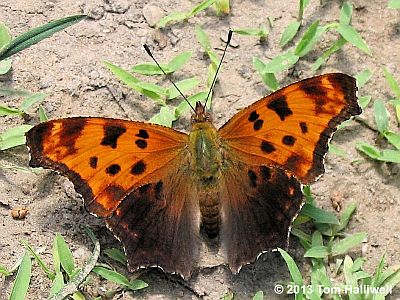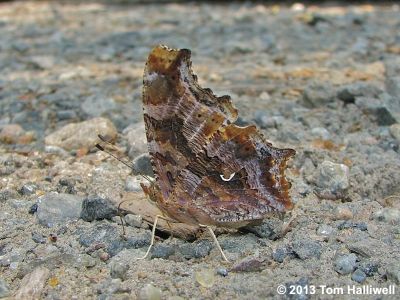New Jersey Butterfly Club
A chapter of the North American Butterfly Association (NABA)
Eastern Comma
Polygonia comma
Identification: Small—1.9” (slightly smaller than Question Mark [QM]). Wing margins distinctly irregular (often more scalloped than QM), with FW hooked at tip and HW tailed. Above (light form): FW and HW bright orange with many black markings, including a line of 3 round spots on FW (NOT capped by a horizontal dash, as in QM); HW with submarginal pale spots and a central dark spot. Above (dark form): FW same as light form, but HW mostly blackish, with some orange near the base. Spotting variably obscured. Below: FW and HW range from rather plain gray-brown (sometimes with pale violet overtones) to distinctly mottled in shades of dark and light brown. HW with silvery mark in center consisting of a short, curved line ("comma"), lacking the separate dot seen in QM.
NJ Status and Distribution: Resident. Fairly common and widespread throughout.

Habitat: In and near woods, where it is usually seen on bare ground, leaf litter, or tree trunks. Sometimes found nectaring in fields and in gardens, especially near woods, but usually found at sap runs, moist ground, or even carrion and dung. Can be attracted to gardens with overripe fruit.
Flight Period: Two broods. Overwintering adults usually begin flying in February or March, producing “dark form” offspring that emerge in late June and July. These summer-flying butterflies produce a “light form” second brood that becomes evident from late August into November, after which they enter hibernation. Extreme dates: North Jersey 2/21—12/4; South Jersey 2/5—12/11.
Caterpillar Food Plants: Nettles (Urtica), woodnettles (Laportea), elms (Ulmus), and hops (Humulus).
Overwintering Stage: Adult.
Good Locations: Dirt roads and parking lots near deciduous woods in Delaware Water Gap NRA, Whittingham WMA, Riverwinds Scenic Trail.
Comments: Not always easy to distinguish from Question Marks as some QMs lack the period under the comma mark. Eastern Comma, Gray Comma, and Question Mark are informally called “anglewings,” referring to the irregular wing margins.

Dark form, Walpack, Sussex Co., NJ, 6/13/05.

Light form, Kittatinny Valley SP, Sussex Co., NJ, 10/3/09.

Mottled form, Willowwood Arboretum, Morris Co., NJ, 6/8/07.

Plain form, DWGNRA (Thunder Mountain), Sussex Co., NJ, 8/20/17.

Commas (and other anglewings) seldom nectar at flowers—this light-form individual is imbibing sap from a Black Birch. Sussex Co., NJ, 4/9/17.

Stack of eggs on Canadian Woodnettle (L. canadensis).

Stinging Nettle (U. dioica) and the very similar Tall Nettle (U. procera) are two important caterpillar food plants for Eastern Comma, Milbert's Tortoiseshell, and Red Admiral.

Canadian Woodnettle is another caterpillar food plant for Eastern Comma.